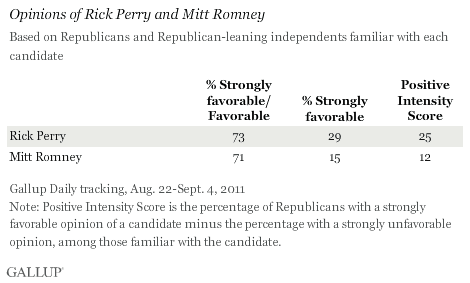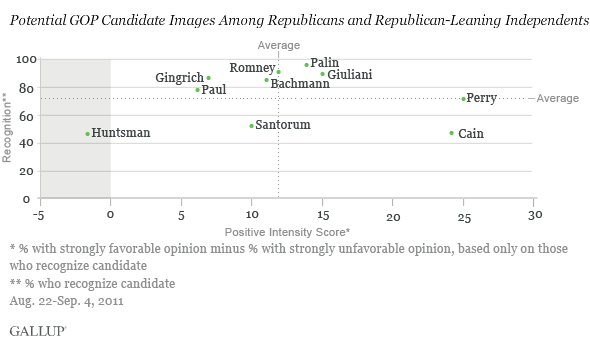PRINCETON, NJ -- Mitt Romney and Rick Perry are, in a broad sense, about equally well-liked by Republicans who are familiar with them, with 73% saying they have a favorable opinion of Perry and 71% of Romney. However, 29% of Republicans familiar with Perry have a strongly favorable opinion of him, compared with 15% who say the same about Romney. As a result, Perry's Positive Intensity Score -- which takes into account strongly favorable and strongly unfavorable opinions -- is twice that of Romney's, 25 to 12.

These results are based on Aug. 22-Sept. 4 Gallup Daily tracking of Republican presidential candidate images. Perry and Romney are the leading candidates for the GOP nomination at this point in time, based on rank-and-file Republicans' current nomination preferences. Perry currently holds a 29% to 17% edge over Romney in preferences for the eight announced candidates; Romney had been the leader prior to Perry's official entry into the race in early August.
Romney remains somewhat better known (88% to 74%), but that gap has closed as Perry's recognition score has surged since early August.
The two, along with other Republican presidential candidates, may square off in a debate Wednesday, which would be the first including Perry. However, Perry's participation is somewhat in doubt as he oversees the government's response to wildfires in Texas.
Most Republican Candidates Well-Liked by Republican Supporters
In general, most Republican presidential candidates are well-liked by Americans who identify themselves as Republicans or say they are independent but lean toward the Republican Party. All but Jon Huntsman receive favorable ratings of 60% or above from those familiar with them. Perry, Romney, and Herman Cain all exceed 70% favorable ratings.
Of the eight announced candidates, Perry and Cain generate the most enthusiasm among Republicans, with Positive Intensity Scores above 20. The gap between these two candidates and the remainder of the field on this measure has widened in recent weeks. Huntsman's Positive Intensity Score has fallen into negative territory, meaning more Republicans who are familiar with Huntsman have a strongly negative opinion of him than a strongly positive one.

Rudy Giuliani and Sarah Palin, who still have not ruled out entering the race, are also well-liked by Republicans (74% and 69% favorable ratings, respectively), but also do not generate the same degree of strong intense feeling as Perry and Cain. Giuliani's current Positive Intensity Score is 15 and Palin's is 13.
Perry Remains Best-Positioned Candidate
Perry's combination of high name recognition and a high Positive Intensity Score help make him the best-positioned candidate for the Republican nomination at this point, underscored by his lead in Republican nomination preferences. Cain's enthusiastic support is offset by his low name recognition, and other well-known candidates like Romney, Michele Bachmann, and Ron Paul, do not generate the same level of intense feeling as Perry.

Implications
Perry's rise in the polls makes him the candidate to beat for the Republican nomination at the moment. His front-runner status means he will increasingly come under attack from his rivals on the campaign trail and in coming Republican candidate debates. The increased criticism could have a negative effect on the way Republicans view him, though if he responds well Republicans may view him in a more positive light.
As the campaign unfolds, it will be clear whether it is sufficient for Republicans to like someone in order to tap him or her as their party's presidential nominee, as would appear to be the case if they nominate Romney or one of several other candidates including Bachmann, Paul, and Palin or Giuliani should they run. Or does the nominee need to generate a sufficiently high level of enthusiasm among the party base in order to win the nomination, as is the case for Perry, even if he is no better liked in a broad sense than many of the other contenders.
Survey Methods
Results are based on telephone interviews conducted as part of Gallup Daily tracking Aug. 22-Sept. 4, 2011, with random samples of Republicans and Republican-leaning independents, aged 18 and older, living in all 50 U.S. states and the District of Columbia. Questions asking about the 10 potential candidates measured in this research were rotated among randomly selected samples of Republicans each night; over the 14-day period, each candidate was rated by approximately 1,400 Republicans and Republican-leaning independents.
For the overall ratings of each potential candidate among Republicans and Republican-leaning independents, including recognition scores, one can say with 95% confidence that the maximum margin of sampling error is ±3 percentage points. For the Positive Intensity Score for each candidate, the maximum margin of sampling error varies depending on the size of the group recognizing the candidate.
Interviews are conducted with respondents on landline telephones and cellular phones, with interviews conducted in Spanish for respondents who are primarily Spanish-speaking. Each sample includes a minimum quota of 400 cell phone respondents and 600 landline respondents per 1,000 national adults, with additional minimum quotas among landline respondents by region. Landline telephone numbers are chosen at random among listed telephone numbers. Cell phones numbers are selected using random digit dial methods. Landline respondents are chosen at random within each household on the basis of which member had the most recent birthday.
Samples are weighted by gender, age, race, Hispanic ethnicity, education, region, adults in the household, and phone status (cell phone-only/landline only/both, cell phone mostly, and having an unlisted landline number). Demographic weighting targets are based on the March 2010 Current Population Survey figures for the aged 18 and older non-institutionalized population living in U.S. telephone households. All reported margins of sampling error include the computed design effects for weighting and sample design.
In addition to sampling error, question wording and practical difficulties in conducting surveys can introduce error or bias into the findings of public opinion polls.
For more details on Gallup's polling methodology, visit www.gallup.com.
